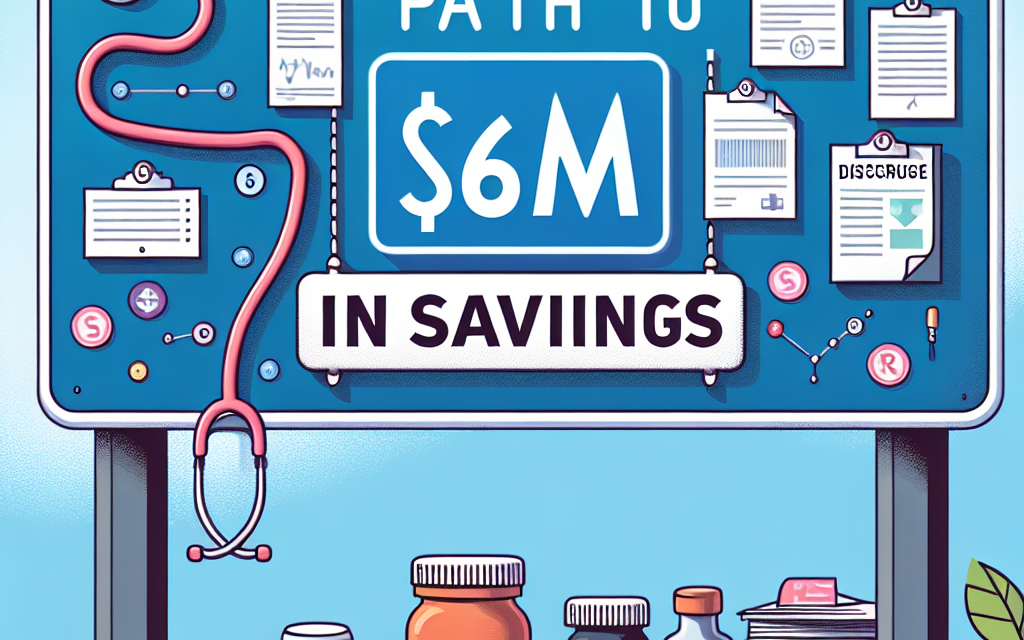Predicting Hospital Discharge: A Path to $6M in Savings
In the ever-evolving landscape of healthcare, the ability to predict hospital discharge dates has emerged as a critical factor in enhancing patient care, optimizing resource allocation, and ultimately saving costs. With healthcare systems facing increasing pressure to improve efficiency while maintaining high standards of care, predictive analytics has become a game-changer. This article delves into the intricacies of predicting hospital discharge, exploring its implications, methodologies, and the potential for significant financial savings—up to $6 million in some cases.
The Importance of Predicting Hospital Discharge
Understanding when a patient is likely to be discharged from the hospital is crucial for several reasons. Accurate predictions can lead to improved patient flow, better resource management, and enhanced patient satisfaction. Here are some key aspects of why predicting hospital discharge is essential:
- Improved Patient Flow: Predicting discharge dates helps hospitals manage bed availability more effectively, reducing wait times for incoming patients.
- Resource Allocation: Knowing when patients will be discharged allows hospitals to allocate staff and resources more efficiently, ensuring that care is delivered promptly.
- Enhanced Patient Satisfaction: Patients who have a clear understanding of their discharge timeline are often more satisfied with their care experience.
- Cost Reduction: By optimizing discharge processes, hospitals can significantly reduce operational costs, leading to substantial savings.
- Better Care Coordination: Predictive analytics can facilitate smoother transitions of care, ensuring that patients receive the necessary follow-up care after discharge.
In summary, the ability to predict hospital discharge dates is not just a logistical concern; it is a multifaceted issue that impacts patient care, hospital efficiency, and financial performance.
Methodologies for Predicting Hospital Discharge
Various methodologies can be employed to predict hospital discharge dates, ranging from traditional statistical methods to advanced machine learning algorithms. Each approach has its strengths and weaknesses, and the choice of methodology often depends on the specific context and available data. Here are some common methodologies:
- Statistical Models: Traditional statistical methods, such as regression analysis, can be used to identify factors that influence discharge timing. These models often rely on historical data to make predictions.
- Machine Learning Algorithms: More advanced techniques, such as decision trees, random forests, and neural networks, can analyze large datasets to identify complex patterns that may not be apparent through traditional methods.
- Natural Language Processing (NLP): NLP can be utilized to analyze unstructured data from clinical notes, helping to identify factors that may influence discharge timing.
- Time Series Analysis: This method involves analyzing data points collected over time to forecast future discharge dates based on historical trends.
- Hybrid Approaches: Combining multiple methodologies can often yield better results, as it allows for a more comprehensive analysis of the factors influencing discharge.
Each of these methodologies has its own set of challenges, including data quality, model interpretability, and the need for continuous updates as new data becomes available. However, when implemented effectively, they can provide valuable insights into discharge timing.
Case Studies: Successful Implementation of Predictive Analytics
Several healthcare institutions have successfully implemented predictive analytics to improve their discharge processes, leading to significant cost savings and enhanced patient care. Here are a few notable case studies:
- Case Study 1: Mount Sinai Health System – Mount Sinai implemented a predictive analytics tool that utilized machine learning algorithms to forecast discharge dates. By analyzing patient data, the system was able to predict discharge dates with an accuracy of over 80%. This led to a reduction in length of stay by an average of 1.5 days per patient, resulting in estimated savings of $4 million annually.
- Case Study 2: Virginia Mason Medical Center – Virginia Mason adopted a predictive model that focused on identifying patients at risk of prolonged hospital stays. By intervening early with targeted care plans, the hospital was able to reduce its average length of stay by 10%, translating to significant cost savings and improved patient outcomes.
- Case Study 3: Geisinger Health System – Geisinger utilized predictive analytics to streamline its discharge planning process. By integrating data from various sources, the system was able to predict discharge dates accurately, leading to a 20% reduction in readmission rates and substantial savings in operational costs.
These case studies illustrate the transformative potential of predictive analytics in healthcare, demonstrating that hospitals can achieve significant financial savings while improving patient care through effective discharge planning.
Challenges in Predicting Hospital Discharge
Despite the promising potential of predictive analytics, several challenges can hinder the successful implementation of discharge prediction models. Understanding these challenges is crucial for healthcare organizations looking to adopt such technologies:
- Data Quality: The accuracy of predictive models heavily relies on the quality of the data used. Incomplete or inaccurate data can lead to erroneous predictions, undermining the effectiveness of the model.
- Integration of Systems: Many hospitals use disparate systems for patient data management. Integrating these systems to create a comprehensive dataset for analysis can be a significant hurdle.
- Staff Training: Healthcare professionals must be trained to understand and utilize predictive analytics tools effectively. Resistance to change can also pose a challenge in adopting new technologies.
- Ethical Considerations: The use of predictive analytics raises ethical questions regarding patient privacy and data security. Ensuring compliance with regulations such as HIPAA is essential.
- Continuous Model Updating: Predictive models require continuous updates to remain accurate as patient populations and healthcare practices evolve. This necessitates ongoing investment in data management and analytics capabilities.
Addressing these challenges is essential for healthcare organizations to fully realize the benefits of predictive analytics in discharge planning.
The Financial Impact of Predicting Hospital Discharge
The financial implications of accurately predicting hospital discharge dates can be substantial. By optimizing discharge processes, hospitals can achieve significant cost savings, which can be reinvested into improving patient care and expanding services. Here are some key financial benefits:
- Reduced Length of Stay: By accurately predicting discharge dates, hospitals can reduce the average length of stay for patients, leading to lower operational costs. For instance, a reduction of just one day in length of stay can save a hospital thousands of dollars per patient.
- Decreased Readmission Rates: Effective discharge planning can lead to lower readmission rates, which are costly for hospitals. By ensuring patients receive appropriate follow-up care, hospitals can avoid the financial penalties associated with high readmission rates.
- Improved Resource Utilization: Predictive analytics can help hospitals allocate resources more efficiently, reducing waste and optimizing staffing levels. This can lead to significant cost savings over time.
- Enhanced Revenue Cycle Management: By improving discharge processes, hospitals can accelerate their revenue cycle, ensuring that they receive payments more quickly and reducing the time spent on billing and collections.
- Potential for $6 Million in Savings: As highlighted in various case studies, hospitals that successfully implement predictive analytics can achieve savings of up to $6 million annually through improved discharge planning and resource management.
In conclusion, the financial impact of predicting hospital discharge is profound, with the potential for significant savings that can enhance the overall sustainability of healthcare organizations.
Conclusion: The Future of Predicting Hospital Discharge
As healthcare continues to evolve, the importance of predicting hospital discharge dates will only grow. With advancements in technology and data analytics, hospitals have the opportunity to enhance patient care, optimize resource allocation, and achieve substantial cost savings. The journey toward effective discharge prediction is not without its challenges, but the potential rewards are significant.
By investing in predictive analytics and addressing the challenges associated with data quality, system integration, and staff training, healthcare organizations can position themselves for success in an increasingly competitive landscape. The path to $6 million in savings is not just a financial goal; it represents a commitment to improving patient outcomes and ensuring the sustainability of healthcare systems.
In summary, predicting hospital discharge is a multifaceted endeavor that requires a comprehensive approach, combining advanced methodologies, successful case studies, and a keen understanding of the financial implications. As we look to the future, the integration of predictive analytics into hospital discharge planning will undoubtedly play a pivotal role in shaping the healthcare landscape.





